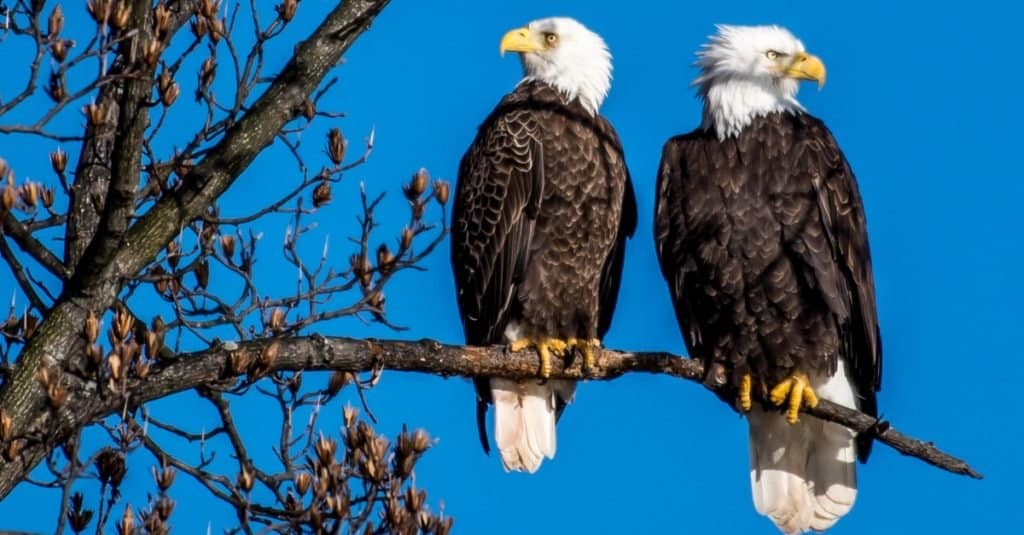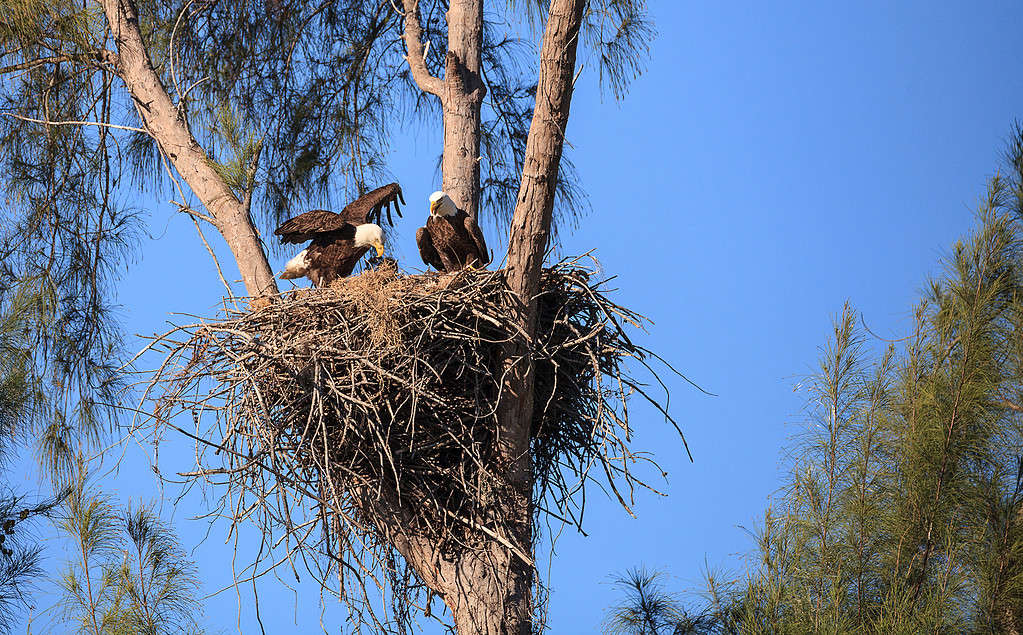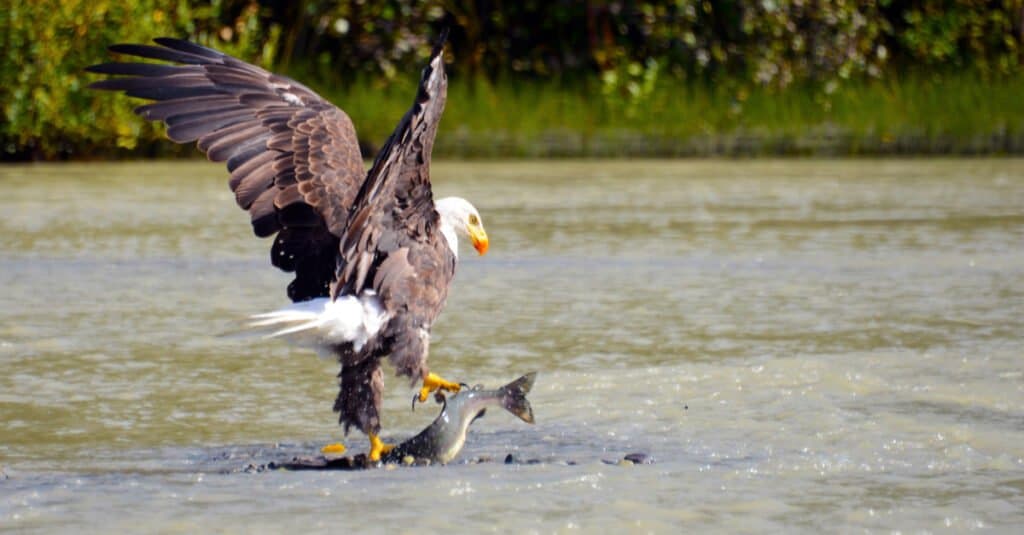Imagine seeing the majestic bald eagle soaring through the skies–a symbol of freedom, power, and resilience.
As the national emblem of the United States, bald eagles have made a remarkable comeback from the brink of extinction. But of Florida vs. Washington State, which state has the most of these beautiful birds?
Join us on an exhilarating journey as we compare Florida and Washington states, delving into the factors that shape their bald eagle populations. We’ll explore the habitats they call home, their fascinating behaviors, and their unique diet.
We’ll also examine the crucial roles they play in the ecosystem. Next, we’ll compare the populations in both states.
Finally, we will reveal the winner in the Florida vs. Washington State bald eagle showdown.
Where Do Bald Eagles Live?

Florida has more bald eagles than Washington.
©Jack Molan/Shutterstock.com
Each of the lower 48 states enjoys a bald population. Here, we’ll uncover the diverse habitats that make up their nesting grounds, adapted to the unique conditions of Florida and Washington State.
Key Features of Ideal Habitats for Bald Eagles
Bald eagles thrive in environments that combine vast forests near bodies of water. Locations such as these provide ample opportunities for hunting, nesting, and raising their young. Large, sturdy trees with wide branches serve as the perfect nesting sites; bald eagles use such trees as they offer safety from predators and a vantage point for spotting prey.
Regional Habitat Preferences
As we journey through Florida and Washington State’s diverse landscapes, let’s examine specific habitat preferences of bald eagles in each region, which shine a light on how these adaptable birds find their niche in the unique ecosystems they inhabit.
- Florida’s habitat variety. In Florida, bald eagles are drawn to subtropical wetlands, coastal estuaries, and river systems, where they can find plenty of fish and other prey.
- Washington State’s unique landscape. Washington’s temperate rainforests, alpine lakes, and rugged coastlines create diverse habitats for bald eagles, who capitalize on the region’s rich salmon runs and diverse marine life.
Threats to Bald Eagle Habitats
Now, as we appreciate the stunning habitats that support Florida and Washington State bald eagles, let’s delve into the challenges these environments face, highlighting the importance of addressing these threats to ensure these iconic birds’ ongoing survival and success.
- Human development and encroachment. As urbanization and development continue to expand, bald eagle habitats are often at risk, with nesting sites and hunting grounds facing destruction or fragmentation.
- Climate change impacts. Climate change poses another threat to bald eagle habitats, as rising temperatures, extreme weather events, and shifting ecosystems may disrupt the delicate balance of their environments.
The Importance of Habitat Conservation
Habitats play an essential role in supporting healthy bald eagle populations. Therefore, ongoing conservation efforts are crucial to ensure they continue to soar in our skies.
Bald Eagle Behavior

Bald eagles are monogamous and often mate for life.
©Krumpelman Photography/Shutterstock.com
Let’s examine the fascinating world of bald eagle behavior and reveal its unique traits.
Mating and Nesting Rituals
As we delve deeper into the captivating world of bald eagle behavior, let’s explore their extraordinary mating and nesting ritual. The rituals reveal the intricate dynamics and cooperation between these lifelong partners as they build and maintain their remarkable homes together.
- Lifelong partners. Bald eagles form monogamous pairs, often staying together for life, displaying remarkable loyalty and cooperation.
- Architectural marvels. Working in tandem, these devoted couples build enormous nests and return each year to add new materials for nest maintenance.
Hunting and Feeding Strategies
Bald eagles have exceptional hunting and feeding strategies. Let’s undercover the skills and adaptability that make these powerful predators masters of the skies and formidable hunters in their ecosystems.
- Masters of the skies. Bald eagles swoop expertly down from the sky and use their sharp talons to snatch fish from the water’s surface or steal prey.
- Opportunistic diners. Not just skilled hunters, these adaptable birds also scavenge for carrion, making the most of available food sources.
Social Interactions and Communication
As we immerse ourselves in the fascinating lives of bald eagles, let’s explore their social interactions and communication methods, unveiling the complex and captivating behaviors that these majestic birds use to connect, cooperate, and thrive within their communities.
- Vocalizations. Bald eagles communicate through a range of vocalizations, from chattering calls to signal territory boundaries to softer sounds exchanged between mates.
- Fierce defenders. They are fiercely territorial, engaging in aerial battles or displays of intimidation to protect their home and family.
Bald Eagle Diet and Feeding Habits
The intriguing diet of the bald eagle fuels these formidable predators as they rule the skies.
Fish Fanatics
Bald eagles have a particular fondness for fish, skillfully plucking their prey from the water with their razor-sharp talons. Depending on their location, bald eagles may favor specific fish species, such as Pacific Northwest salmon or Florida mullet.
Opportunistic Scavengers
These adaptable birds won’t shy away from a free meal, scavenging carrion when the opportunity arises. By consuming carcasses, bald eagles help to recycle nutrients and prevent the spread of disease within their environment.
Hunting Techniques
Bald eagles are known for their impressive aerial hunting skills. When bald eagles hunt, they use their keen eyesight and powerful wings to spot and capture prey. However, they aren’t above stealing a meal from other predators, such as ospreys, showcasing their intelligence and opportunism.
Appreciating Their Resourcefulness
The bald eagle’s diverse diet and resourceful feeding habits reveal their adaptability and their integral role in maintaining balance within their ecosystems.
Role of Bald Eagles in the Ecosystem
As we soar through the skies with these magnificent birds, let’s explore the vital roles bald eagles play in the ecosystems they inhabit.
Apex Predators
As top predators, bald eagles help control prey populations, maintaining a healthy balance in their food chains. Their predation can have cascading effects on the ecosystems, positively influencing the overall health and diversity of plant and animal species.
Masters of Clean-Up
By scavenging carcasses, bald eagles contribute to nutrient cycling and help keep ecosystems clean and free from the spread of disease. In addition, their role as scavengers highlights the interconnectedness of nature, as each species plays a part in sustaining the health of its environment.
Indicator Species
Bald eagles serve as indicator species, with their population trends often reflecting the overall health of the ecosystems they inhabit. By monitoring bald eagle populations, scientists can identify potential threats or changes in environmental conditions, prompting conservation action when needed.
Bald Eagle Population in Florida

Bald eagles make their home throughout Florida, often around the Gulf Coast and other forest habits near water.
©iStock.com/LagunaticPhoto
Let’s head south to Florida, where bald eagles flourish in the state’s diverse habitats and bountiful waterways.
Historical Context
Once threatened by widespread DDT use and habitat loss, Florida’s bald eagle population made a triumphant comeback through dedicated conservation efforts. Legal protections, habitat conservation, and public awareness campaigns have contributed to the resurgence of these magnificent birds in Florida.
Current Population Status
Today, Florida boasts a thriving bald eagle population, with about 1,500 nesting pairs scattered across the state. From the Panhandle to the Everglades, bald eagles can be found nesting and hunting in a variety of environments, showcasing their adaptability.
Factors Contributing To Population Growth
As we celebrate the remarkable comeback of bald eagles in Florida, let’s delve into the key factors that have contributed to their population growth, showcasing the power of concerted conservation efforts and the resilience of these majestic birds.
- Habitat conservation. Protecting and restoring essential habitats, such as wetlands and coastal areas, has been vital in supporting Florida’s bald eagle population.
- Legal protections. State and federal regulations, such as banning DDT and enforcing the Bald and Golden Eagle Protection Act, have significantly contributed to their recovery.
- Abundant food sources. Florida’s rich aquatic ecosystems provide plentiful food sources for bald eagles, ensuring their continued success in the state.
A Story of Resilience and Triumph
The remarkable recovery of Florida’s bald eagle population is a testament to conservation’s power and a symbol of hope for future generations.
Bald Eagle Population in Washington State

Bald eagles in Washington State thrive thanks to conservation efforts.
©jbieger/Shutterstock.com
Let’s journey to Washington State, where bald eagles grace the skies amidst lush rainforests, rugged coastlines, and thriving waterways.
Historical Context
Much like their Floridian counterparts, Washington’s bald eagles faced threats from DDT and habitat loss, putting their survival at risk. However, through concerted conservation efforts, legal protections, and habitat restoration, Washington’s bald eagles experienced a significant resurgence.
Current Population Status
Washington State now hosts a robust bald eagle population, with about 900 nesting pairs scattered across its diverse landscapes. In winter, Washington’s Skagit River Valley becomes a hotspot for bald eagles, attracted by the abundant salmon runs.
Factors Contributing To Population Growth
As we admire the inspiring resurgence of bald eagles in Washington State, let’s explore the various factors that have played a role in their population growth, highlighting the importance of dedicated conservation actions and the adaptability of these awe-inspiring birds.
- Habitat conservation. The preservation and restoration of key habitats, such as old-growth forests and riparian zones, have been crucial for Washington’s bald eagle population.
- Legal protections. The ban on DDT and the enforcement of protective regulations have played a significant role in the recovery of these majestic birds in Washington State.
- Rich food sources. Washington’s diverse marine and freshwater ecosystems provide plentiful food options for bald eagles, supporting their growing population.
An Inspiring Tale of Resilience
The remarkable resurgence of Washington’s bald eagle population stands as an inspiring story of conservation success and a beacon of hope for wildlife preservation efforts.
Comparing Florida and Washington State Bald Eagle Populations
Now that we’ve explored Florida and Washington’s unique landscapes and thriving bald eagle populations, let’s compare and contrast these majestic birds in each region.
Population Size
As we compare the soaring success of bald eagles in Florida and Washington State, let’s take a closer look at the population sizes in each region, revealing the unique stories of recovery and triumph that these majestic birds represent.
- Florida’s flourishing population. With thousands of nesting pairs, Florida’s bald eagle population has made an incredible recovery, contributing significantly to the overall population in the United States.
- Washington State’s impressive numbers. While Washington State also hosts a healthy bald eagle population, it is slightly smaller than Florida’s, with fewer nesting pairs overall.
Habitat Differences
To truly understand the nuances between Florida and Washington State bald eagle populations, let’s examine each region’s distinct habitats, showcasing how these magnificent birds have adapted to the diverse environments that make each location unique.
- Florida’s subtropical charm. Bald eagles in Florida benefit from the state’s diverse ecosystems, including wetlands, coastal estuaries, and river systems.
- Washington State’s lush landscapes. In Washington State, bald eagles thrive amidst temperate rainforests, alpine lakes, and rugged coastlines, capitalizing on the region’s rich aquatic resources.
Food Sources
As we continue comparing bald eagle populations in Florida and Washington State, let’s examine their regional dietary preferences. The bald eagles’ diverse food sources in their respective habitats influence their survival and success.
- Florida’s aquatic bounty. Fish species such as mullet and various crustaceans make up the primary diet of bald eagles in Florida.
- Washington State’s salmon runs. Washington State’s bald eagles rely heavily on the region’s abundant salmon runs, other marine life, and freshwater fish species.
The Verdict
While both Florida and Washington State boast thriving bald eagle populations, Florida takes the crown. The Sunshine State enjoys a slightly larger population.
The Bigger Picture
Ultimately, the true victory lies in the resurgence of these iconic birds in both states. The result reminds us of the importance of habitat preservation, public awareness, and ongoing conservation efforts.
Key Takeaways
We’ve soared through the skies of Florida and Washington State, comparing the awe-inspiring bald eagle populations in each region. After an in-depth look at habitat, food sources, and conservation efforts, we’ve discovered which state has the most bald eagles.
Our finding underlines the importance of continued monitoring, protection, and strategic planning to ensure the success of these iconic birds. As symbols of American pride and resilience, and indicators of environmental health, the thriving bald eagle populations remind us of our responsibility to protect and preserve our precious natural world.
The photo featured at the top of this post is © jbieger/Shutterstock.com
Thank you for reading! Have some feedback for us? Contact the AZ Animals editorial team.







